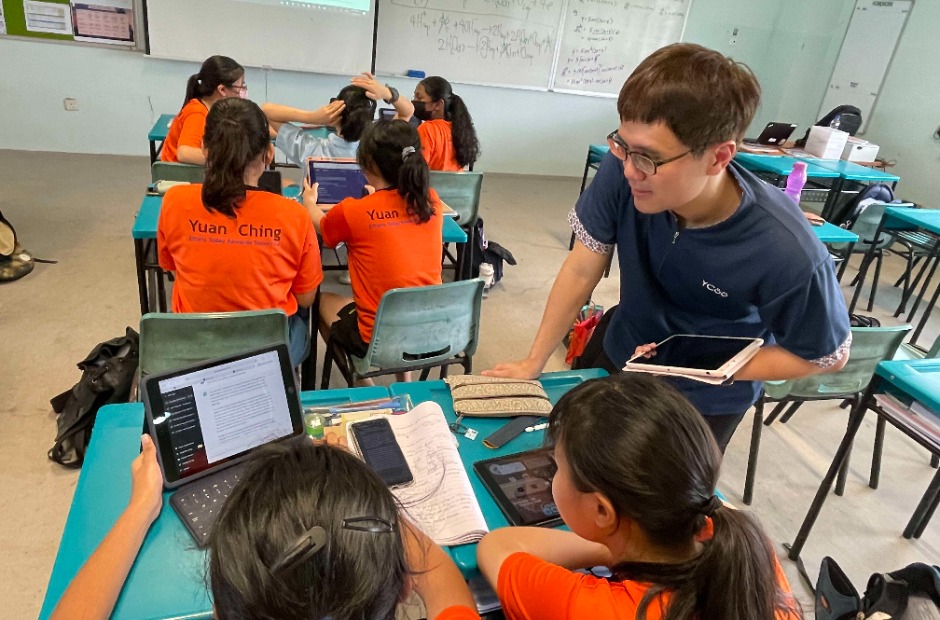Discussions around the generative artificial intelligence (AI) tool, released by AI research firm OpenAI late last year, have been polarising – some call it a complement and helpmate, others have called for a ban, predicting its ability to wipe out jobs and upend life as we know it.
Yuan Ching Secondary School Chemistry teacher Leung Yulun, a President’s Award for Teachers 2021 Recipient, has been watching the scene since the start of the year, when he shared his newly composed Chemistry song with his Science colleagues. One of them mentioned ChatGPT’s potential for composing similar songs, which sparked Mr Leung’s interest to explore the generative AI tool further. With some research and exploration, he started deploying it in the classroom.
It is no surprise that he would be an early adopter – he has been known for all kinds of creative ways to interest his students in their studies.
He understands the fuss around the tool. ChatGPT draws and processes information from deep wells of content and can deliver fairly elaborate answers and perform tasks such as summaries and analyses. Chat with it and it sounds almost human — and friendly too. With that ease of use, however, “some students may struggle with the purpose of homework or take-home assessments, and as a result, they may unintentionally hinder their own learning by resorting to plagiarism”, says Mr Leung.
Since AI is not something we can keep at bay, he believes we should try to make the best of it while taking steps to teach students about responsible and ethical use of tools like ChatGPT.
For the past month, he has been trialling ChatGPT in class and it has worked out so well, he now calls it his “digital teaching assistant”.
In the spirit of scientific inquiry
 Getting students to develop their questions, hypotheses, and theories, is just one of the ways Mr Leung uses ChatGPT to facilitate inquiry-based learning.
Getting students to develop their questions, hypotheses, and theories, is just one of the ways Mr Leung uses ChatGPT to facilitate inquiry-based learning.
Now, at the end of the class, students may clarify their learning against what ChatGPT throws up, and evaluate the accuracy of the information it generates before sharing their thoughts with Mr Leung – this process of evaluation is very much in line with the spirit of scientific inquiry.
Mr Leung then filters through their responses, and focuses on the more complex queries.
- “Having ChatGPT as a teaching assistant was interesting. We used it to review our learning, and I’ve learnt more about how technology can support us in our daily lessons!”
- “Using ChatGPT allowed me to use my critical skills to discern whether the concepts explained by ChatGPT are in line with what I learnt.”
- “ChatGPT enhanced my understanding of electrolysis as it helps to clarify my doubts when I ask ‘him’ questions. However, its answers are limited in credibility and accuracy, so it’s important to cross-check with other sources to evaluate whether the answers are correct or not.”
- “ChatGPT gave me a fresh perspective on electrolysis. In addition to our teachers, I think that it can be a useful tool to aid in my studies.”
A chance to rethink assessment
Mr Leung points out that using ChatGPT for learning, not cheating, offers students a chance to ask smart questions, think critically, and consider different viewpoints.
Mr Leung himself has been thinking deeper thanks to ChatGPT – about how easy these generative tools could make for students to get lazy about their homework or cheat on online tests. This calls for teachers to relook and communicate the purpose of such assignments, and assessment on the whole.
“The primary objective of homework is to aid students in consolidating their learning into manageable portions,” he emphasises. Teachers then review the homework to “make informed decisions to better plan for their next phase of learning”.
‘Like having a friend in your pocket’
.jpg)

 Mr Leung ran the lyrics of his songs “Chemical Bonding is so Easy” by ChatGPT to see what key concepts it reveals.
Mr Leung ran the lyrics of his songs “Chemical Bonding is so Easy” by ChatGPT to see what key concepts it reveals.
If teachers fear that the tools may take over as the primary instructor one day, Mr Leung prefers to look on the bright side – these tools could help them become even better teachers. “ChatGPT has the potential to complement teachers as effective facilitators, freeing us up to focus on promoting critical thinking, problem solving, and collaborative skills.”
He challenges sceptics to think differently about generative AI tools; in the right hands, it has the potential to be a powerful tool for teaching and learning.







